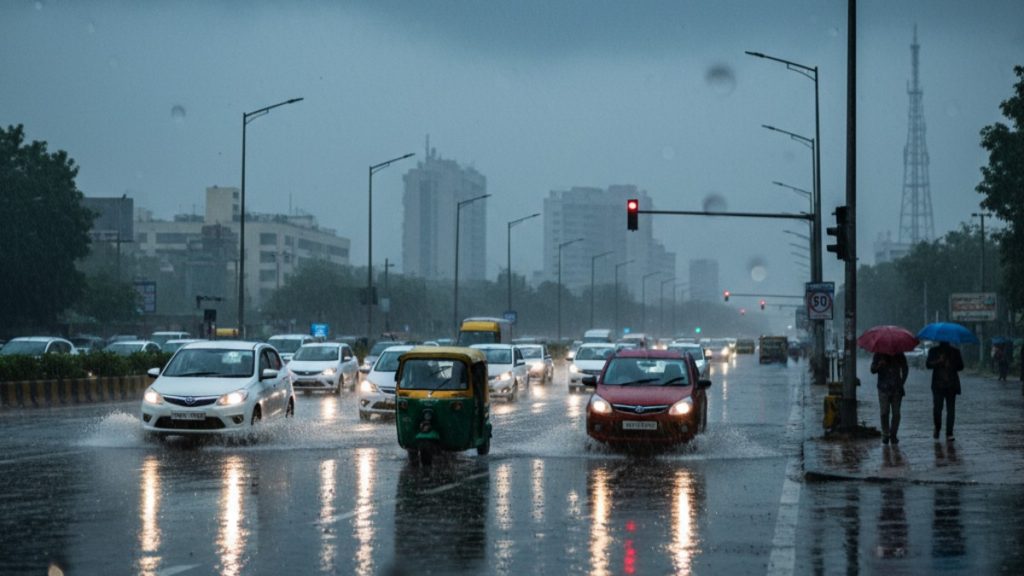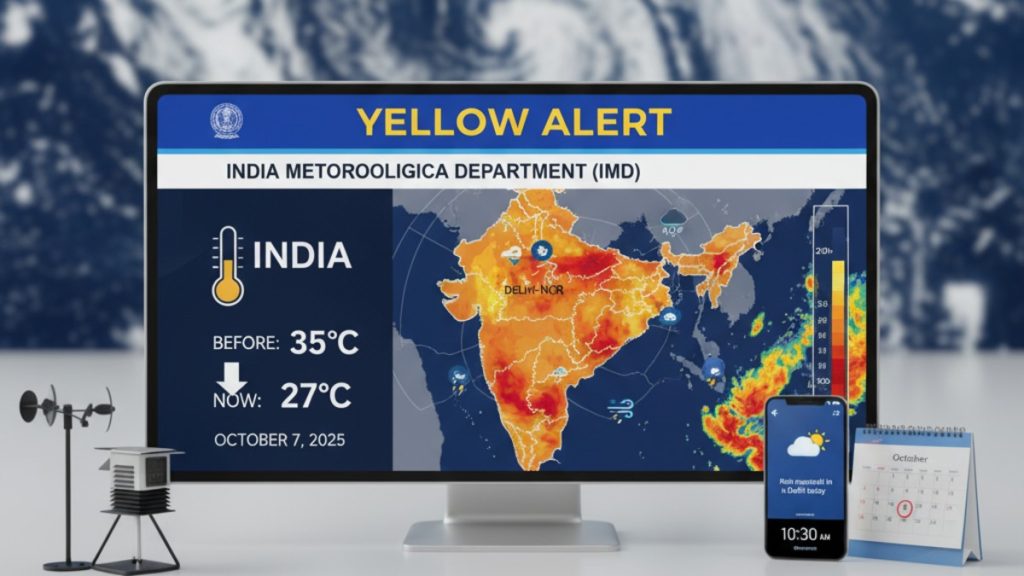
Delhi Weather, Delhi-NCR experienced significant relief from the recent hot spell as rain lashed parts of the capital on Monday and Tuesday, bringing a dramatic temperature drop and much-needed respite. Rain brought relief from the hot and humid conditions that had persisted over the past several days, though it also caused waterlogging and traffic disruptions across multiple areas.
The Indian Meteorological Department (IMD) has issued a yellow alert for the region as a western disturbance continues to influence weather patterns. Here’s what residents need to know:
- Temperature dropped by 8°C, marking the coolest October in two years
- Waterlogging reported at multiple locations causing traffic chaos
- Yellow alert active with thunderstorms and gusty winds expected
Read Also: Ladakh Protests Turn Violent as Gen Z Demands Statehood
Today’s Weather Condition: What You Need to Know
Under the influence of western disturbance, maximum rainfall activity was expected for October 6, 2025, extending up to the forenoon of October 7, 2025. The weather activity is expected to reduce significantly thereafter, with partly cloudy skies becoming mainly clear.
The temperature in Delhi has witnessed a remarkable drop, providing relief to residents who had been dealing with unseasonably warm conditions. The rain brought an 8°C temperature drop, making it the coolest October in two years.
Current weather parameters include moderate humidity levels and wind speeds reaching 20-30 kmph with occasional gusts. The Meteorological Department has been closely monitoring the situation and providing regular updates to help residents plan their day accordingly.
Rain and Thunderstorm Alert: IMD Weather Update
The IMD issued a yellow alert for Delhi-NCR, indicating that residents should be prepared for potential weather-related disruptions. The alert warned of light rain expected Sunday evening with thunderstorms forecasted for October 6-7.
The yellow alert status signifies moderate intensity weather conditions that require public awareness. The weather forecast suggests that while the intensity of rainfall will decrease after October 7, occasional light showers may continue for a few more days.
For neighboring areas like Ghaziabad, conditions were more severe. Ghaziabad received an orange alert with generally cloudy sky and light to moderate rain accompanied by thunderstorms and lightning, with wind speeds at 30-40 kmph and gusts reaching 50 kmph.
Understanding the IMD weather forecasting system helps residents prepare better for sudden weather changes during the monsoon season and post-monsoon periods.
Traffic Disruption and Waterlogging: Ground Reality
The rain today brought significant challenges for commuters across Delhi-NCR. Multiple areas reported severe waterlogging, leading to traffic jams and road diversions.

Approximately 20 calls were received at the PWD’s flood control room regarding waterlogging on Tuesday, including areas like Raja Garden Chowk, Shahdara, Wazirabad bridge, and A-block Hari Nagar.
Traffic police issued multiple advisories throughout the day as several key routes became difficult to navigate. The Zakhira Railway Underpass on Road No 40 experienced severe waterlogging leading to diversions, with traffic from Shastri Nagar-KD Chowk diverted towards Chaudhary Nahar Singh Marg.
Major affected areas included:
Ring Road sections saw slow-moving traffic, particularly near South Extension and Lajpat Nagar. Aurobindo Marg experienced near-standstill conditions due to waterlogged stretches. Outer Ring Road faced challenges with water accumulation affecting vehicle movement.
Commuters are advised to check real-time traffic updates and allow extra travel time when planning their journeys. Alternative routes and public transport options can help avoid heavily congested areas during such weather conditions.
Will It Rain Today? Tomorrow’s Weather Forecast
For those wondering “will it rain today” or “what will the weather be like tomorrow,” the outlook suggests improving conditions. After the forenoon of October 7, weather activity will significantly reduce with partly cloudy sky becoming mainly clear sky thereafter.
The weather information indicates that the western disturbance responsible for the current rainfall is moving away from the region. This means residents can expect:
Gradual clearing of skies over the next 24-48 hours with reduced chances of rainfall. Temperature stabilization with pleasant daytime conditions expected. Lower humidity levels as the weather system moves eastward.
For accurate hour-by-hour predictions, residents can check the India Meteorological Department’s official website or various weather tracking applications that provide hyperlocal forecasts.
The rainy season in Delhi typically extends from July through September, though October can still witness occasional showers due to retreating monsoon conditions and western disturbances.
Understanding Western Disturbances and Their Impact
The current rain meteorological department data points to a western disturbance as the primary cause of this weather pattern. These extratropical storm systems originate from the Mediterranean region and travel eastward, bringing moisture-laden winds to northwestern India.
Western disturbances are particularly significant during winter months but can occur during the post-monsoon period as well. They typically bring:
Sudden temperature drops due to cloud cover and precipitation. Rainfall accompanied by thunderstorms and lightning. Strong gusty winds that can reach 40-50 kmph.
These weather systems play a crucial role in providing winter rainfall to northern India, which is essential for the rabi crop season. Understanding weather patterns and climate systems helps explain why Delhi experiences such varied weather conditions throughout the year.
Delhi Weather: Historical Context and Patterns
This October’s weather has been particularly noteworthy. Delhi NCR is experiencing the coolest October in two years as rain brings an 8°C temperature drop, making it a significant departure from recent trends.
Historically, October marks the transition from monsoon to winter in Delhi. The weather condition during this month can be unpredictable, with temperatures ranging from 20°C to 35°C. This year’s early cooling trend is welcomed by residents who had been experiencing warmer-than-average temperatures in September.
The temperature fluctuations during October are influenced by multiple factors including:
Retreating monsoon patterns that can bring late-season rainfall. Western disturbances starting to affect the region more frequently. Clear nights leading to rapid cooling after sunset.
Climate experts monitor these patterns closely as they provide insights into broader climate trends and help improve long-term weather prediction models.
Safety Tips During Thunderstorms and Heavy Rain
When the Meteorological Department issues alerts, residents should take appropriate precautions. Here are essential safety measures during thunderstorms and heavy rain:
For Drivers: Avoid waterlogged areas as they can hide potholes or open manholes. Drive slowly and maintain extra distance from other vehicles. Turn on headlights even during daytime for better visibility.
For Pedestrians: Avoid walking through flooded streets where water depth is uncertain. Stay away from electricity poles and hanging wires. Seek shelter in sturdy buildings during lightning and thunderstorms.
General Precautions: Keep emergency contact numbers handy including traffic police and disaster management authorities. Monitor weather updates regularly through reliable sources. Avoid unnecessary travel during peak rainfall hours.
The National Disaster Management Authority provides comprehensive guidelines for dealing with various weather-related emergencies.
Impact on Daily Life and Infrastructure
The rain has had mixed effects on Delhi’s daily operations. While providing much-needed relief from heat and improving air quality temporarily, it has also exposed persistent infrastructure challenges.
Waterlogging remains a recurring issue despite government efforts. The IMD explained that the rainfall was driven by a well-marked low-pressure system, which brought more precipitation than initially forecasted.
The weather today affected various sectors including:
Transportation: Delays in metro services due to waterlogging near some stations. Slow-moving traffic on major arterial roads. Flight delays and cancellations at Indira Gandhi International Airport during peak rainfall hours.
Business Operations: Many offices implemented work-from-home policies for employee safety. Retail and hospitality sectors experienced reduced footfall. Delivery services faced delays due to poor road conditions.
Education: Some schools issued advisories allowing students to stay home if conditions were severe. Online classes were conducted in several institutions.
Understanding these weather impacts on urban infrastructure helps city planners develop better mitigation strategies.
Government Response and Preparedness
Delhi authorities have been proactive in responding to weather-related challenges. The PWD’s flood control room operates 24/7 during such conditions to coordinate relief efforts.
Read Also: DGCA Orders Urgent RAT Reinspection on Air India Boeing 787s
Ahead of the monsoon, Delhi flagged 71 critical waterlogging hotspots with departments launching new accountability systems, real-time monitoring, and emergency plans.
The government’s multi-pronged approach includes:
Regular desilting of drains before and during the rainy season. Deployment of pumps at known waterlogging points. Real-time traffic management with dynamic diversions. Public communication through social media and official channels.
These measures aim to minimize disruption and ensure public safety during adverse weather conditions. Residents can report waterlogging and traffic issues through dedicated helpline numbers and mobile applications.
Air Quality Improvement: A Silver Lining
One positive outcome of the rain today has been the improvement in air quality. Delhi’s air quality index (AQI) showed noticeable improvement as rainfall helped settle dust particles and pollutants.
The weather update indicates that this temporary relief from pollution could last a few days, depending on wind patterns and additional rainfall. However, experts caution that sustained improvement requires long-term policy interventions beyond weather-dependent factors.
Post-rain periods typically see:
Reduced particulate matter concentration in the air. Better visibility across the city. Slight decrease in respiratory discomfort for sensitive groups.
Monitoring air quality data helps residents plan outdoor activities and take necessary health precautions.
Regional Weather Patterns: Beyond Delhi
The western disturbance affecting Delhi weather has also impacted neighboring states. Uttarakhand, Himachal Pradesh, Uttar Pradesh, and Bihar have experienced varying degrees of rainfall and thunderstorm activity.
Hill states like Himachal Pradesh and Uttarakhand received heavier precipitation, with some areas reporting snowfall at higher altitudes. This early season precipitation is beneficial for agriculture and water resources in these regions.
The interconnected nature of weather systems means that conditions in one region often influence neighboring areas, highlighting the importance of comprehensive meteorological monitoring across northern India.
FAQs About Delhi Weather and Rain
Q: Will it rain today in Delhi?
Based on current IMD forecasts, light rain is possible during the morning hours of October 7, but weather activity is expected to reduce significantly by afternoon. The western disturbance that caused heavy rainfall is moving away from the region.
Q: What will the weather be like tomorrow in Delhi?
Tomorrow’s weather is expected to show improvement with partly cloudy to mainly clear skies. Temperatures will remain pleasant with reduced chances of rainfall. However, residents should stay updated with latest forecasts as weather patterns can change.
Q: When will the rainy season end in Delhi?
The traditional monsoon season ends by September in Delhi. However, October can still witness occasional rainfall due to western disturbances and retreating monsoon conditions. The current rainfall episode is expected to be one of the last significant rain events until next monsoon.
Q: How accurate are IMD weather predictions?
The India Meteorological Department uses advanced technology including Doppler radars, satellites, and numerical weather prediction models. Short-range forecasts (24-48 hours) typically have high accuracy of 85-90%, while longer-range predictions have lower certainty. Following official IMD updates provides the most reliable weather information.
Wrapping Up
The current weather condition in Delhi-NCR represents a typical October scenario with western disturbances bringing unexpected rainfall. While the rain has provided relief from heat and improved air quality, it has also highlighted ongoing infrastructure challenges related to waterlogging and traffic management.
As weather patterns stabilize over the coming days, residents can look forward to pleasant autumn conditions. Staying informed through official channels and taking appropriate precautions during adverse weather ensures safety and minimizes disruption.
What’s your experience been with the recent weather changes in Delhi? Have you noticed the temperature drop, and how has it affected your daily routine? Share your thoughts in the comments below.
Article Sources:
Read Also: Trump’s $100,000 H-1B Visa Fee Shake-Up: What It Means for You, India, and U.S. Tech
- Information compiled from India Meteorological Department
- Weather data referenced from Outlook India Weather Reports
- Traffic updates from Business Standard India News
- Additional context from BBC Weather and Reuters India Coverage
Original Source Credit:
- News18 Hindi – Delhi NCR Rain Live Update
- Live Hindustan – Delhi Weather Coverage
- Amar Ujala – Top Headlines Today